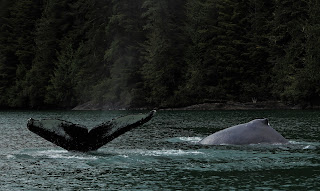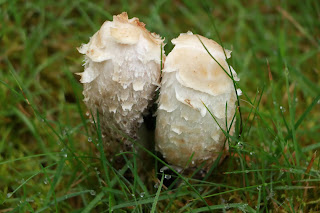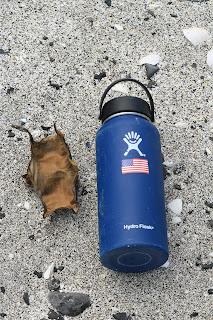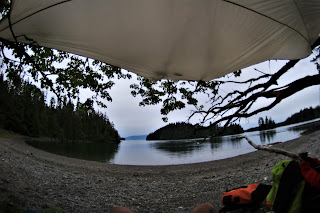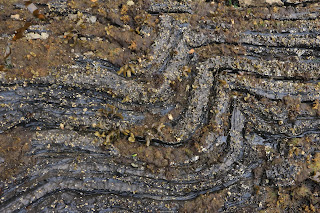This post is about two island groups that lie to the east of Prince of Wales Island a little more than an hour by boat from Wrangell, the Kashevarof and the Blashke Islands. This area is far from the silt laden waters around Wrangell where the Stikine River empties into the sea and clouds the water for many miles with the massive amount of glacial silt the river has picked up over its 300 mile length. These waters of the Stikine River affect the sea life in the Wrangell vicinity as the silt and the millions of gallons of freshwater dispersing into the saltwater limit what ocean creatures can survive here near Wrangell. The subject area of this post is unaffected by Stikine waters making it more typical of what a person thinks when they think of the ocean - jellyfish, anemones, whales, sea birds, kelp beds, and all mysterious denizens of the deeps.


This is a nautical chart view of the subject islands of this post. Nautical charts are an artform in themselves in my opinion and provide a lot of information about the waters of an area. An eye trained to read and recognize the features a chart reveals would see that there are many narrow passages, reefs, rocks, shallow waters and other navigational hazards in these two groups of islands making them a perfect place to explore by paddle craft. When I did whale watching tours, I did spend many hours poking around this area as there are always whales here but it was somewhat nerve wracking and limiting by in a large boat with an easily damaged propeller. I have wanted to explore this area by kayak for several years now and am very happy to have finally done it although the 5 nights that we spent here went by much too quickly and my mind is still there wishing the rest of me was there as well. Being a "responsible adult" isn't my favorite thing.

This is a view that I haven't had enough of in my life in the last few years. It has been too long since I have done a multiple night kayak trip. I was admittedly a little rusty in the packing strategy for a long kayak trip and sitting in a kayak for long periods of time requires some getting used to but thankfully, the weather did its part to make our trip pleasant as we blew the dust off of our kayaking skills. I was also learning how to use a recently purchased wide angle fish eye lens which allowed for this photo.

This is Andrea early in the trip doing her Orca summons to let the orcas know that we were in the area and that they should come by sometime while we were there. It might seem a little silly or hippy dippy but I have personally seen this work which resulted in the Whale Language post I did in June of 2019. I have read accounts from Orca researchers who have admitted that they have sometimes felt that there was some sort of telepathic communication between them and the orcas in the sense that the orcas seemed to know what they were thinking. I have had 3 experiences in my life that make me tend to think there may be some truth to this although admittedly, coincidence could also explain these experiences. Whether telepathy, coincidence, or divine intervention, those experiences were outstanding ones in my memory that struck me as significant.
This area has a relatively commonly seen pod of orcas as well as lots of kelp beds, sea otters, seals, whales, and excellent beach combing beaches providing lots of opportunities for discovery and awe. I went into this trip expecting (or hoping for) some amazing whale encounters envisioning photos of breaching behemoths and new flukes to add to the library of whales we have identified in the area but the trip ended up being one more of interesting geology, flowers, and one awesome bird nerd experience. There were whales, many whales, but we had no whale encounters that stood out as exceptional to our high standards.
Oh well, beautiful scenery, isolation, and the freedom of wild shores would just have to suffice!
It has been a rather cold and rainy summer so far this 2020, just another thing that has made this year one that I am looking forward to ending, but we got lucky and had a nice week of weather for this trip. It wasn't always sunny, most days had a mixture of sun and clouds, but the only rain we experienced was on our last afternoon and evening when we were comfortably sitting in camp chairs on the beach under a tarp anyway.
This isn't an edited photo ( I do very little editing and have yet to try advanced editing programs like Lightroom), Andrea was really glowing when I looked over at her as we were taking photos of some Common Loons nearby on the water. It was raining in the distance but sunny where we were creating this cool contrast.
Weaving our way through some labyrinthine passages that allow a shortcut through the Blashkes.
These islands lie at the furthest end of a large body of water that reaches all the way down to Ketchikan and the outside ocean called Clarence Strait. This strait can be a beautiful, placid mirror or a terrifying maelstrom of angry dark water and all variations in between. Winter storms here can produce winds over 100 mph and seas of 20 feet. Many years ago, while being shuttled from Wrangell to the NE side of Prince of Wales Island (POW) for a late fall deer hunting trip with some friends, I experienced one of these storms. It is a boating experience that I will never forget - blowing sideways snow mixed with wind whipped sea spray, a sea of white caps and green water, wave troughs deep enough to be unable to see over when the boat was in them, it was intense.
Our sea conditions were much gentler with only a few hours of stiff breezes and mild chop on the water to deal with, otherwise it was smooth paddling. This area of winter storms results in some excellent opportunities for beach combing as well as some significant barriers of battered logs blocking access to the forest where the trees and beach meet. We did find some wilderness treasures in the form of cool rocks, interesting sea life, and a perfectly good inflatable buoy. Unfortunately, plastic detritus is very common on any wild shoreline so we found a lot of that as well but not enough to ruin our sense of solitude and wildness.


Some examples of the weather beaten, storm lashed beaches in this area. Some of the most windward facing beaches have a significant barricade of battered logs that can reach all the way up into the forest. Any recognizable characteristics identifying the original tree species of these logs has long since been beaten, worn, sandblasted, and rubbed away leaving the limbless, rounded, and bleached remnants here on these remote beaches. These trees could have come from anywhere in the world and could contain exotic species from far off lands. When I was in Kodiak earlier this year, I found a western red cedar log on a beach there, the nearest red cedar growing in a forest to Kodiak is found a very short distance north of Wrangell. Wrangell is about 20 miles south of the farthest northern limit of western red cedars. While the island of Kodiak really isn't much farther north in latitude than Wrangell, it is on the other side of the Gulf of Alaska a couple thousand miles away.
A pretty rock
The pretty lavender colored inside of a dead and broken urchin.
The thing in the above two pictures is a mermaid's purse, probably a term that the most "woke" social justice feminists among us would protest and find offensive, after all, can't a merman also have a purse? Sorry, back to reality - a mermaid's purse is actually an egg case for a variety of sharks, stingrays, and skates. It is a tough leathery case that protects the developing animal until it is ready to hatch and swim away into the vast ocean. I don't know what species this one came from but I'm going to assume it was some sort of skate since they are common here. The water bottle it is next to is a one liter bottle so the purse itself is about 6 inches long.
These were some sort of very pretty shellfish washed up on a beach attached to a very small log. I didn't know what these were exactly when I found them, but have been informed by my friend Ceona that they are goose barnacles. Thanks for the knowledge Ceona!
When I first caught sight of this rock on the beach, I thought I had found some human created sculpture of a skull, maybe some ancient Aztec death god washed up on a remote Alaska beach. On closer inspection, it was an even more interesting sculpture sculpted by time, water, and sand into something that to my biased human perspective looks like a figurine of a human skull. How this stone came to look this way is incomprehensible to me. I can ponder on the natural processes of erosion, the softness of the stone, the weathering processes and all the other factors that resulted in this particular image and still be awed by the natural world and all of the aspects of it that remain mysterious and unknown.
At this time of year, another common sight on the beaches are wildflowers, in some places lots of wildflowers.
Red Paintbrush.
A member of the mint family, Self Heal.
Red Columbine in the midst of a jumble of driftwood.
Harebells
A type of orchid called Coralroot that grows in the forest under trees with open understory.
I think I mentioned earlier in this post that we did not have too many outstanding wildlife encounters on this trip although the whales and sea otters were abundant and seen many times each day. There are deer on these islands and I will assume there are some black bears but we saw neither. An odd feature of these islands is that there are no squirrels so the absence of their chattering was noticeable at times.

This was the best I could do as far as sea otter photos. It was difficult to get close enough to them with my limited lens capabilities and photography from a bobbing kayak presents some challenges as well. These guys were all over the place, some had pups on their chests as they floated by, others were occasionally whacking on some sort of shellfish with a rock, all of them looked rather relaxed in these protected waters in their kelp forests. I spent some time one evening contemplating sea otters as they relate to evolution and creationism. Yep, that is my brain. As I will assume everyone knows, sea otter fur has been highly prized and has been very valuable for centuries which at one time led to the near extermination of the species as fur traders, in this area, Russian fur traders, hunted them voraciously. Sea otter fur is so valuable because of its exquisite softness, thickness, and beauty. It gets these qualities from the fact that there are one million hairs per square inch on a sea otter's hide. This is what keeps these animals warm in the cold northern Pacific waters, this and a nearly constant need to eat in order to burn caloric energy. Other marine mammals, seals, sea lions, whales, porpoises, have a thick layer of blubber that insulates them from the cold water, a much less energy demanding strategy and one requiring much less maintenance. These facts are what led me to my contemplation of evolution and creationism. I guess now that I think about it, that skull rock also made me contemplate evolution and creationism as well.
For quite some time now, I have been puzzled by this philosophical argument. Why do we limit ourselves to one of the two? It is rare to find an evolutionist who also believes in a higher power while most creationists discount any aspects of evolution. These dichotomous paths in reason have always confounded me and seem to do more to distract us from the truths of life than to reveal them, it's a way to divide (literally) and limit thought. In my thinking, the combination of evolution and creationism leads down a path of truth.
Evolution relies on the belief that all living things are results of genetic mutations that benefit an organism and are passed to the following generations and that this has happened over unimaginable amounts of time. There are many aspects of this belief that are scientifically provable and make sense to me but it takes out any sense awe of the world for me. Its cold reliance on chance seems nihilistic and, for me, does not explain the beauty of nature adequately. The Golden Mean comes to mind as do those flowers that somehow had genetic mutations that led to them looking EXACTLY like the female of the species of insect that pollinates them so the male will visit the flower and get the pollen in EXACTLY the right place to pollinate the flower. Isn't it more beautiful to think that maybe there was some exquisite hand at work there?
Creation, on the other hand, seems too easy of an explanation, too much like the work of a magician to me. The POOF! there it is theory is how I think of it. God created everything exactly how it is today in 6 days. Even if we interpret "days" as some time period that could be much longer than 24 hours, my thought of God is of a much more complicated, incomprehensible Being with the ability to do things we cannot even think about like maybe creating a system in which random chance, environmental conditions, and scientific laws with some influence by an unseen influencer has resulted in the miracle in which we live. My thought is that a God would have no problem creating a system in which creatures evolve over time into ever different forms, this, to me, is Godlike. I see science and the hand of something bigger everywhere in nature, random chance and genetic mutations fail to fully explain the wonder around us to me nor does an old man on a throne in the sky pointing his finger and saying "Be so!" God is much more beautiful and terrifying than that.

A visitor looking to spend the night in our tent.
The same visitor after Andrea transplanted it onto a safer and more photogenic surface.
A starfish hanging out until the tide comes back in.
The next pictures are of our bird nerd experience of the trip. We were exploring a small island with extensive sand and gravel bars and eelgrass flats exposed at low tide when we heard a bird sound that was unfamiliar,
Did you notice the battered aluminum skiff in the bottom picture? You never know what you will find on these beaches.
These are the birds that made the uncommon sound, Black Oystercatchers. This is the first time that I have seen them in Alaska and we ended up seeing 3 of them total, these two out on the rocks and then one more that flew in and got the other two to fly away. Fortunately, we found one of them on the island where we could get closer to them for better photos, well, I got some better photos but unfortunately, Andrea's memory card on her camera was full and her extra one was several hundred yards away packed in her kayak. Photography can be frustrating at times!
How about some random pictures that I don't really know how to fit into the narrative part of this blog?




One interesting feature of these islands is that there is little freshwater. This is a temperate rainforest and this summer has been a very wet and rainy one but potable water is still scarce here. The islands are mostly rather small with little topography, the tallest islands are around 500 feet high, and the bedrock is predominantly limestone which could drain water away in some unseen tunnels or caves. We had planned for this reality bringing enough water with us for the first 3 days and I used a hunting app with satellite imagery to scout possible water sources that could sustain our water supply for the remainder of the trip but the on the ground truth was that we had difficulty in finding good drinking water. The first places we checked that looked like possible streams turned out to be nothing so we paddled to a place where there were 2 small bodies of water not far from the beach. These turned out to be shallow and somewhat stagnant but we filled up a water bag and treated it just to have some water and then paddled on to the next possibility which was a small lake on one of the larger islands. This seemed more promising as I quickly heard the beautiful sound of water running over rocks as I walked up the nearly dry streambed. It is good to do without things and be in situations that require a person to appreciate the many things that we take for granted like water. We weren't stranded in a desert wilderness and we weren't near death from dehydration but I was very thankful for that water running over those rocks. I did not want the rest of trip to be spent paddling from spot to spot hoping for water while I got more and more stressed being concerned for Andrea's well being and her enjoyment of our trip. The source of the water was a pretty lake created by a huge, old beaver dam nestled between low hills covered in salal beneath the trees. Giardia? What? Beaver fever? Of course I thought about that and we did treat this water as well to be safe although I drank at least a liter of it untreated as I was beginning to get a headache from inadequate hydration. I have not filtered my "wild" water for probably 2 decades now and have never gotten sick so I have either been lucky or I have a powerful gut!!


Looks fine!
Our last campsite was our favorite and will be one visited again in the future. It had a great sloped gravel beach protected from the outside waters, a beautiful forest with level tent spots, some really interesting geology, and........ a freshwater spring just around the corner from where we camped that trickled out of the limestone onto the beach with just enough volume to be able to use a coffee cup to fill all of our water containers in about 5 minutes! Delicious cold water that needed no filtering or treating of any kind. We couldn't ask for a more perfect place to spend the last two nights of the trip.
The simplicity of living from a backpack or kayak has always appealed to me and is probably what hooked me a long time ago. Tents bring me a kind of joy and a well placed tarp is like having an additional room in your temporary home.
The forest was extensively carpeted with False Lily of the Valley and some huge ferns. It was beautiful.
This was an idyllic spot to camp with the added benefit of being one of the wider and deeper passages allowing for whales to pass by us several times a day not far from shore. Probably half a dozen whales went by us as we sat on the beach and on a couple of occasions I quickly launched my kayak and sprinted after them.
You might be able to hear my heavy breathing in the video as a whale travelling at a leisurely whale pace still swims at about 7 knots requiring the whale obsessed paddler to really put some power into his strokes.
After one of my mostly fruitless chases, I stopped to explore a very small island that was really nothing more than a large rock high enough above the water to have been populated by a surprising number of plant species. The falling tide exposed much of this rock and revealed numerous tide pools in the jagged limestone. It was hard to photograph these pools in a way that really gives them credit but they were very interesting and beautiful.
Such a cool discovery! This nondescript unnamed rock was one of the highlights of this trip for me and I intend to explore it again in the future. It was a fairly treacherous rock to wander around on as the exposed and weathered limestone presented a walking surface much like walking on the edge of a serrated knife blade that was also covered with barnacles in some places. It was like walking on razor blades on top of a serrated knife blade while wearing sandals. I made it off the rock unscathed though thanks to Vibram soles and caution.
I found these interesting fish skulls in a crevasse above that tide pool. I have no idea what kind of fish they are but it was an interesting find.
The view from under the tarp.
Just a few photos of these rugged, jagged, beautiful limestone shores.
Some of the interesting geology found on the beach.
Maidenhair ferns
A petroglyph we found. It's difficult to figure out what this depicts and I have no idea how old it is. It may be a mystery.
What an absolutely fantastic trip!! And to finish off this post, how about a Heart in Nature to say goodbye.



